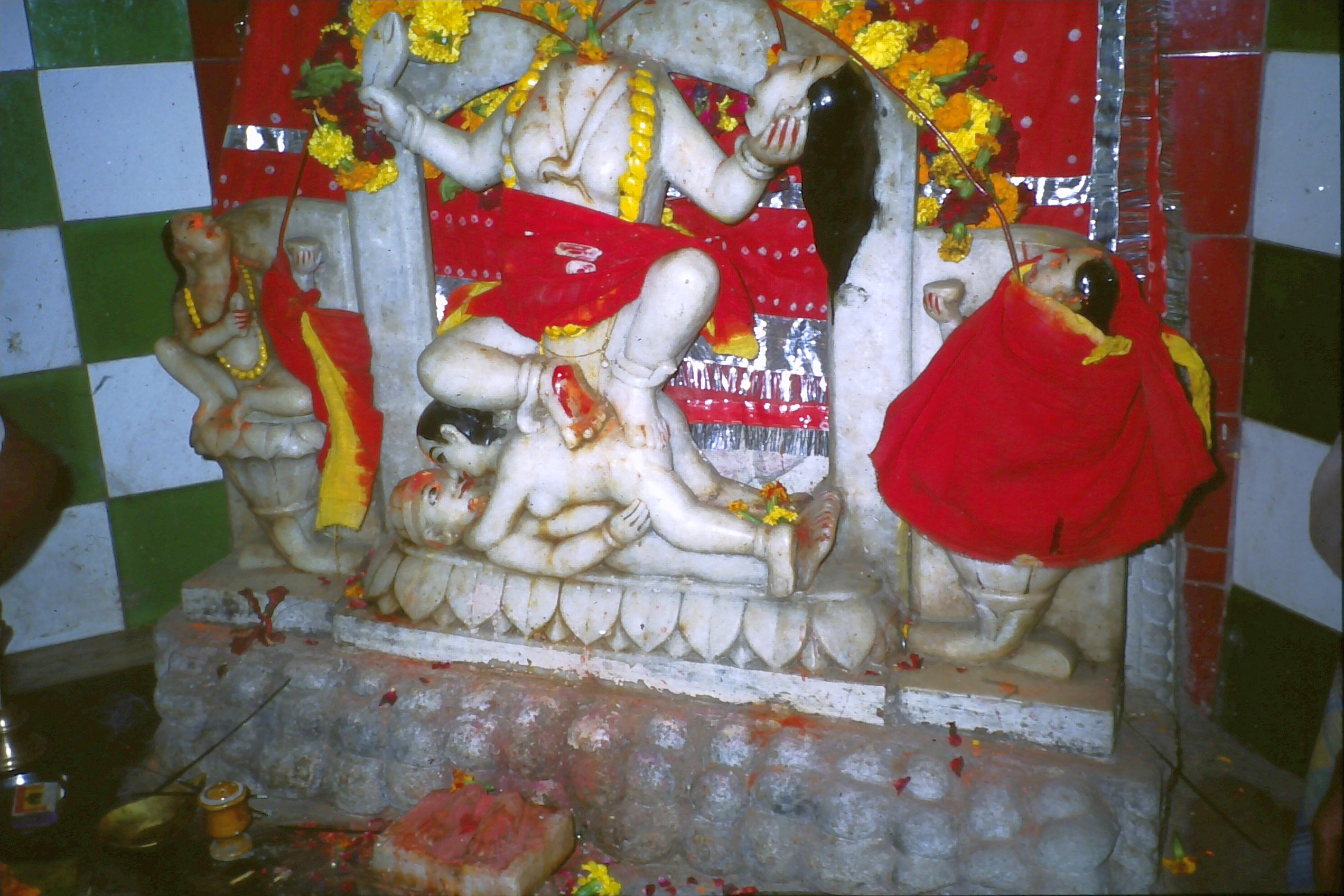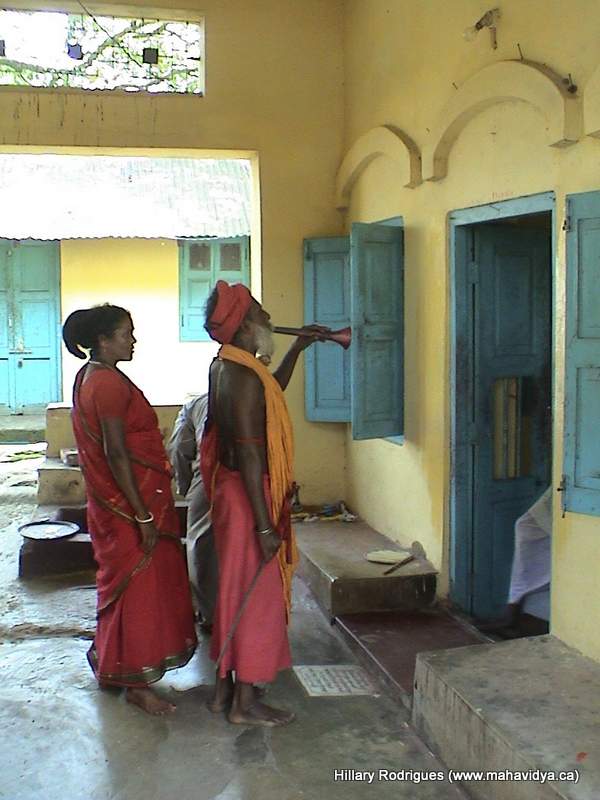Tripurasundari: The Goddess of Three Cities
Beauty is often thought of solely in its external form, usually toward a material object of one’s desire, but in Tantric teachings, beauty lies in the truth, leading to the realization of the Ultimate Self or the Absolute (Frawley 86). The goddess Tripurasundari embodies the means by which beauty is derived through the perception of the universe where one can eventually determine Brahman (the Absolute) (Frawley 89). In Sankrit, Tripurasundari’s name breaks down into Tri “three” Pura “cities” and Sundari “Beauty” therefore meaning the “Beauty of Three Cities” (Brooks 59; Frawley 89). She represents a pathway that enables a worshipper to find samadhi (state of consciousness), giving her the designation as a Vedic goddess of knowledge, which she expresses through her triple natured characteristic.
Her tripartite theme is repeated in multiple forms under the three different cities (these cities are sometimes referred to as worlds). The cities represent how one experiences consciousness within our three bodies: the senses (eyes), the mind and the heart, each symbolizing a city (Frawley 89). Consciousness can be experienced by two different pathways either through the physical, astral and causal pathway or through matter, energy and thought (Frawley 89). Consciousness itself can also be split into waking, dream, and deep sleep (Brooks 125; Frawley 89). When combining these components and separating them into the various cities respectively they form one of the multiple tripartite natures of Tripurasundari.
Tripurasundari is often represented through her iconic yantra (instrument) of a Sri Cakra (holy wheel) (Foulston & Abbott 119). Yantras are very important in Tantric Hinduism, often used during the contemplative yogic practice of sabija samadhi (using an object to help concentrate on the topic of contemplation) as a medium for worship of the goddess. This symbol depicts nine interlinking triangles that fan out from the central point (bindu); they are encircled by two rings of lotus petals all of which are enclosed by a square (Bose 112).
Another important channel of worship is through her Sri Vidya mantra (Bose 112; Foulston & Abbott 119). There are multiple versions of the mantra containing either fifteen or sixteen syllables (Brooks 87; Bose 112;Frawley 92). These mantras follow Tripurasundari’s nature of three where each line represent three sections of the goddess’s body. The three kutas (sections of the mantra) are divided as follows: the first kuta is Tripurasundari’s head, kuta two is her torso and kuta three embodies the area below her hips (Frawley 92). The mantra also ties in the goddess’ relation to the male gods Brahma, Visnu, and Siva (Brooks 94; Frawley 92). The mantra combines both of Tripurasundari’s bodily representations and the male gods sections to relate to the Rig Veda, Yajur Veda, and Sama Veda (Frawley 92). At the end of each kuta is the syllable Hrim and if repeated by itself this sound is often enough to be used as worship (Brooks 94; Frawley 91). In the instances where a sixteenth syllable is spoken (Srim), patrons are found to be repeating all sixteen vowels in the Sankrit language (Brooks 96; Frawley 92).
Tripurasundari is a strong and dominating goddess within Tantric Hinduism which has led to feminine theology based schools and cults. She is linked to the Trika schools where the Sati trinity of the supreme energy exists in the triple patterns (cities, existence, consciousness, etc.) of Tripurasundari (Bose 112).
Tripurasundari is known by many different names across various texts and stories. One of the most famous narratives describing Tripurasundari’s various forms is Lalitasahasranama, portraying over a thousand of her identities and spiritual characteristics (Foulston & Abbott 133). One of these names is Lalita, meaning lovely (Brooks 59). Also known as the Divine Mother, Lalita is the most beautiful and blissful goddess, who resides on Mount Meru (a cosmic mountain), evoking the concept that awareness (of Self) is a joyful experience (Frawley 89). It is unknown if Lalita and Tripurasundari were once combined as one supreme goddess of if they represented two separate goddess (Brooks 59). Both Lalita and Tripurasundari uses the Sri Cakra as her symbol (although there slight variations in multiple forms of the yajna [Brooks 189-199]), as well as Om for her manta, both of which combine to represent her significance in the universe.
Sodasi (she who is sixteen) is another version of Tripurasundari as a young girl whose childlike nature and innocence, often described as a virgin, and is associated with the sixteen-syllable mantra (Brooks 1107; Frawley 90). Tripurasundari is also known as Rajarajeshavai (Supreme Ruler of the Universe or the Queen of Kings) whose authority wills followers to yield to her spiritual command in order to gain insight and knowledge of the Absolute (Brooks 61; Frawley 90).
Commonly, in the Hindu tradition all goddesses may be referred to as one single being known as Devi (goddess) or Mahadevi (great goddess) (Kinsley 132). The Lalitasahasranama text describes numerous goddesses of the Mahadevi all of which assert their own claim to some form divine sakti (power) (Kinsley 132). Many theologies and mythologies account for the various goddesses at differing times in history, often building on one another in order to describe a specific characteristic of the feminine deities more clearly. In one account, Devi is said to manifest herself through the Mahavidyas. Mahavidyas, translated as “Great Knowledge”, can also be referred to as the Dasamahavidyas, the “Ten Great Revelations” (Foulston & Abbott 116).
Tripurasundari is one on the ten Mahavidyas. Historically, the ten goddesses that compose the Mahavidyas have each individually been mentioned in mythology prior to the origin of their group manifestation in the story of Siva and Sati (Kinsley 161). Kinsley gives a brief description of the origin of the Mahavidyas (Kinsley 162). Sati, daughter of King Daksa, is the consort of Siva. Daksa invites all gods and goddesses to the performance of a grand yajna (ritual); however, his invitation does not include Sati and Siva due to Daksa’s aversion for Siva. Greatly offend by not receiving an invitation, Sati declares that she will still attend the yajna. Siva tries to forbid Sati from going to the sacrifice but she becomes enraged and transforms herself into the ten Mahavidyas scaring Siva with their fearsome nature.
The story of Siva and Sati gives one of the most famous depictions of the ten goddesses involved in the group: Kali, Tara, Tripurasundari, Chinnamasta, Bhuvanesvari, Bagala, Dhumavati, Kamala, Matangi, and Bhairavi. Foulston and Abbott state that “Each of the individual goddesses is associated with a particular mental perfection (siddhi) or mode of perception”, symbolizing various stages of consciousness (Foulston & Abbott 117). Kali (the black goddess) is portrayed as the primary Mahavidyas shown as a fierce and dangerous goddess who is seen standing atop Siva (Foulston & Abbott 118; Kinsley 162). Tara (the goddess guide through troubles) is the second goddess in line of the Mahavidyas and she like Kali embodies a fierce and powerful essence associated with death and destruction (Foulston & Abbott 118; Kinsley 162). In her images she greatly resembles Kali and standing in an almost identical position on top of Siva’s corpse. Tripurasundari is often shown to follow Kali and Tara in the manifestations of Devi. Also depicted sitting astride a prone Siva, she is sometimes described as being fearful and dangerous, however this is in contrast to her usual auspicious, beautiful and benign characteristics (Foulston & Abbott 119).
Tripurasundari is sometimes described as her form as Sodasi, the young sixteen year old girl. In whichever form she is illustrated, Tripurasundari is said to have a complexion as red as the rising sun and she is wearing a crown upon her head with an image of a crescent shaped moon (Frawley 91). She is associated with the moon, which symbolizes one of the three bodies, the mind; again this represents how her beauty can cause transcendence and lead to a blissful joyous state (Brooks 125; Frawley 90). She is shown sitting naked upon a prone Siva amidst copulation on top of a cot wearing multiple adornments. The cot’s legs are composed of the gods Brahma, Visnu, Rudra, and Indra (sometimes known as Mahesvara) signifying her energy’s control and complementary role with the male god Siva and his four other forms (Kinsely 163; Frawley 91). Frawley (91), describes the symbols that she carries within her four hands. In one hand she holds a sugar cane bow while another clasps five flower arrows. The bow represents the mind, the arrows signify the five senses and she uses these items to shoot worshipers with delight, leading to a blissful state and consciousness in which one can become aware of the Absolute. Her other hands contain a noose which captures patrons with her beauty and the hook in her fourth hand is used to sever one’s illusion of beauty as an external object.
With in the Hindu tradition, may theologies present the duality between male gods and female goddesses as being the pivotal factor of creation under the control of Brahma (Bose 113). The prior description of Tripurasundari and Siva’s Tantric union represent the polarities of creation between the male static principle and female dynamic principle (Bose 113). Although Siva is seen as the Supreme god in his fivefold element with Brahma (the creator), Visnu (the preserver), Rudra (the destroyer), and Mahesvara (or Indra; Ignorance) his principle essence of creation is unable to sustain its ability without the cosmic sakta (power) of Tripunasundari (Bose 113; Frawley 91). She is the sustenance that drives Siva’s power by means of her triple natured energy of creation, preservation, and destruction (Bose 112). She is known for both her creative and destructor roles in creation but often the destructive role is suppressed, only being brought to attention during mythologies such as the story of the ten Mahavidyas.
Tripunasundari is an important goddess within the Tantric tradition. Her essence is embodied in the trilogy nature relating to all categories of the cosmos and control over the god Siva and his role in the creation of the universe. Her beauty signifies her ability to guide her followers along a pathway that leads to the pure perception of the universe ultimately realizing a clear consciousness that can lead one to the awareness of Brahma, the Absolute. These components make her a powerful goddess among the many that comprise the great goddess Mahadevi.
REFERENCES AND FURTHER RECOMMENDED READING
Bose, Mandakranata (2000) Faces of the Feminine in Ancient, Medieval, and Modern India. New Delhi: Oxford University Press.
Brooks, Douglas Renfrew (1996) Auspicious Wisdom: The Texts and Traditions of Srividya Sakta Tantrism in South India. New Delhi: Manohar Publishers & Distributors.
Foulston, Lynn & Abbott, Stuart (2009) Hindu Goddesses: Beliefs and Practices. Eastbourne: Sussex Academic Press.
Frawley, David (1996) Tantric Yoga and the Wisdom Goddesses: Spiritual Secrets of Ayurveda. New Delhi: Shri Jainendra Press.
Kinsley, David (1986) Hindu Goddesses: Visions of the Divine Feminine in the Hindu Religious Tradition. Berkeley: University of California Press.
Related Topics for Further Investigation
Brahma
Dasamahayidyas
Devi
Dewali Puja
Lalita
Lalitasahasranama
Mahadevi
Mahavidyas
Maha Pithasthans
Mount Meru
Rajarajeshyahi
Sodasi
Siva
Sri Cakra
Sri Mantra
Sri Vidya
Trika school
Tripurasundari Temple
Noteworthy Websites Related to the Topic
http://en.wikipedia.org/wiki/Tripura_Sundari
http://www.hindupedia.com/en/Sri_Vidya
http://en.wikipedia.org/wiki/Trika
http://en.wikipedia.org/wiki/Maheshvara#Maheshvara
[Article written by: Jessie Kress (March 2013) who is solely responsible for its content]







